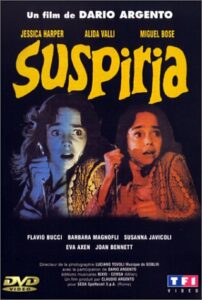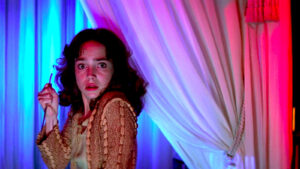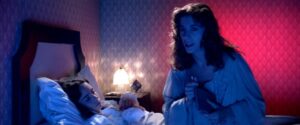“Suspiria” – a Dark Tale in Technicolor [Review]

Title: “Suspiria”
Release Date: 1977
Director: Dario Argento
Cast: Jessica Harper, Joan Bennett, Alida Valli, Stefania Casini
“Suspiria”, directed by Italian master of horror cinema Dario Argento, is a cult horror movie whose plot is reminiscent of well-known folk tales of the German-speaking area. The film’s above-average artistic qualities – stunningly colorful cinematography and a shiver-inducing soundtrack – will make it appeal to more than just fans of the genre.
“Suspiria” (1977) is the first part of the Three Mothers trilogy, which was directed entirely by Dario Argento. However, neither the second part, titled Inferno in 1980, nor the last one – filmed after almost thirty years – Mother of Tears (2007) enjoyed as much success as “Suspiria”. In 2018, the picture lived to see a remake, with Luca Guadagnino behind the camera.
The original “Suspiria” is a movie from the horror subgenre called giallo (Italian for “yellow”). The trend refers to the covers of gory crime novels popular in post-war Italy, which were usually printed using yellow. Giallo flourished in Italian cinema in the 1970s. Films from this trend can be described as a kind of entertainment cinema, which shocked viewers with accurate depictions of violence and sex. However, as Ludwika Mastalerz argues, in the case of the most prominent giallo “the murder scenes are not so much frightening, but rather mesmerizing with the beauty of the imagery and the rhythm of the action.” This is precisely the case with “Suspiria”.
The film tells the chilling story of a young American girl named Suzie (played by Jessica Harper), who arrives in Germany to start studying at a renowned dance school there run by witch teachers. Cruel crimes occur on the spot….

Snow White and other “Suspiria” inspirations
On a plot level, “Suspiria” draws inspiration from a 19th-century collection of fairy tales written down in German by the Brothers Grimm. It is not without reason that the action of this horror film is set in the writers’ homeland. Already in the opening scenes of the film you can see that the ballet school where the main character goes is hidden among the trees. The forest, in countless fairy tales, is a symbol of some kind of mystery, and in this sense it appears, for example, in Little Red Riding Hood. In addition, knocking on the door of Suzie’s academy is wearing a white dress, a clear reference to “Snow White”. The creators of the script, moreover, did not hide the fact that “Suspiria” is based on this literary work.
Allusions to the famous magic fairy tale popularized by the Brothers Grimm can also be found in the construction of the film’s female characters. [It should be noted that “Suspiria” is dominated by women in terms of numbers, and men appear only as supporting characters, even episodic ones. This is probably due to the fact that German folk tales were originally invented and then passed down orally by women]. In Dario Argento’s horror film, we can divide the female characters into two distinct camps: beautiful, young and innocent students of the ballet school, and older, unattractive female employees of the institution who envy their female students’ freshness and beauty. This model clearly reflects the complicated relationship between Snow White and her Stepmother. In essence, “Suspiria” is about the age-old and firmly rooted conflict in Western culture between good and evil, beauty and ugliness, youth and old age, innocence and experience.
However, for the director of the film, this – after all, rather stereotypical – plot is just a pretext for showing something more on the screen. What determines the uniqueness of Dario Argento’s horror film is its form.
“Suspiria” and its three colors
“Suspiria” was filmed along the lines of a dreamy nightmare, and the sultry and dark mood of the story is conveyed by the Art Nouveau setting, Luciano Tovoli’s excellent cinematography and his deliberate use of color play. While watching this horror film, one can notice that in scenes taking place during the day, the colors of the frames are natural and slightly subdued, symbolizing the relative safety of the characters. On the other hand, with the onset of night, the cinematography becomes overdrawn and monochromatic; blood reds and intense greens and blues dominate, intensifying the atmosphere of horror and death lurking around the corner. This effect was made possible by the use of technicolor.

Technicolor was a popular method of shooting color images in old Hollywood. At the time, films were fixed on several different tapes – red, green and blue, and when they were superimposed on each other, a wider range of colors was obtained. It is these three primary colors that fill the nighttime frames of “Suspiria”.
Of course, these visual treatments do not reflect reality, but only symbolize the emotional states of characters in danger and flawlessly convey their anxiety. The same function is performed in the film by the brilliant soundtrack.
“Suspiria” – whispers and screams
The music for “Suspiria” was composed by an Italian progressive rock band called Goblin. In addition to the typical instruments of this musical genre, the artists also used the sounds of the Greek bouzuki and the Indian tabla and sitar, which they supplemented with rousing whispers and screams. The soundtrack was consulted with the director at the production stage and was recorded even before the film was shot. De facto, it is the soundtrack that is the greatest merit of Suspiria, but certainly not the only one.
Interestingly, during the screening of this horror film one can experience the intermingling of diegetic sounds, i.e. those that are part of the presented world, and extra-diegetic sounds. This means that at times it can be difficult for the viewer to distinguish which sounds are actually audible to the characters, and which are elements of film music aimed solely at the audience. Or perhaps these mysterious “noises” are just a figment of the characters’ imagination…?
Literature:
Bielańska Anita, “Spadkobiercy neorealizmu i włoskie kino gatunków” [w:] “Historia kina, t. 3.: Kino epoki nowofalowej”, red. Lubelski Tadeusz, Sowińska Iwona, Syska Rafał, Universitas, Kraków 2015.

